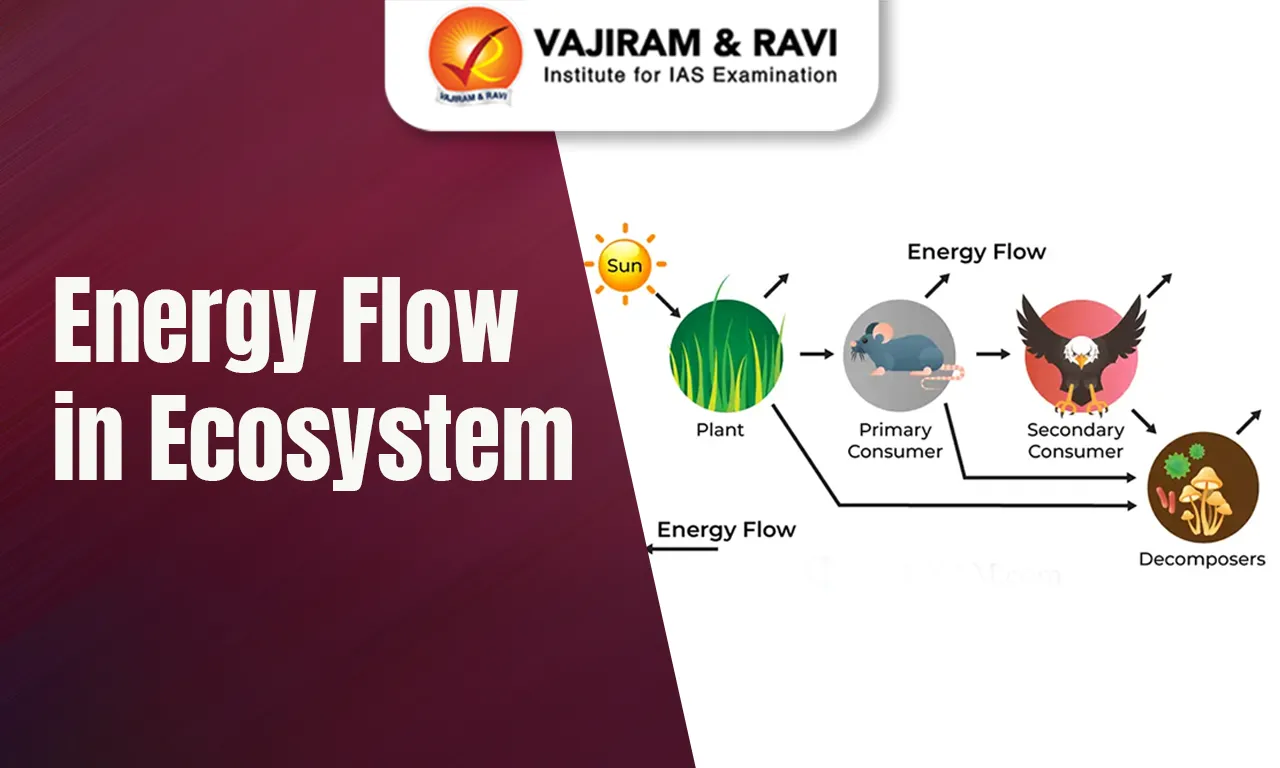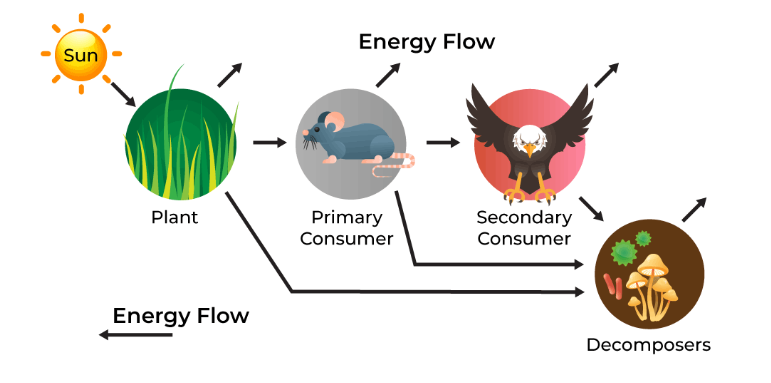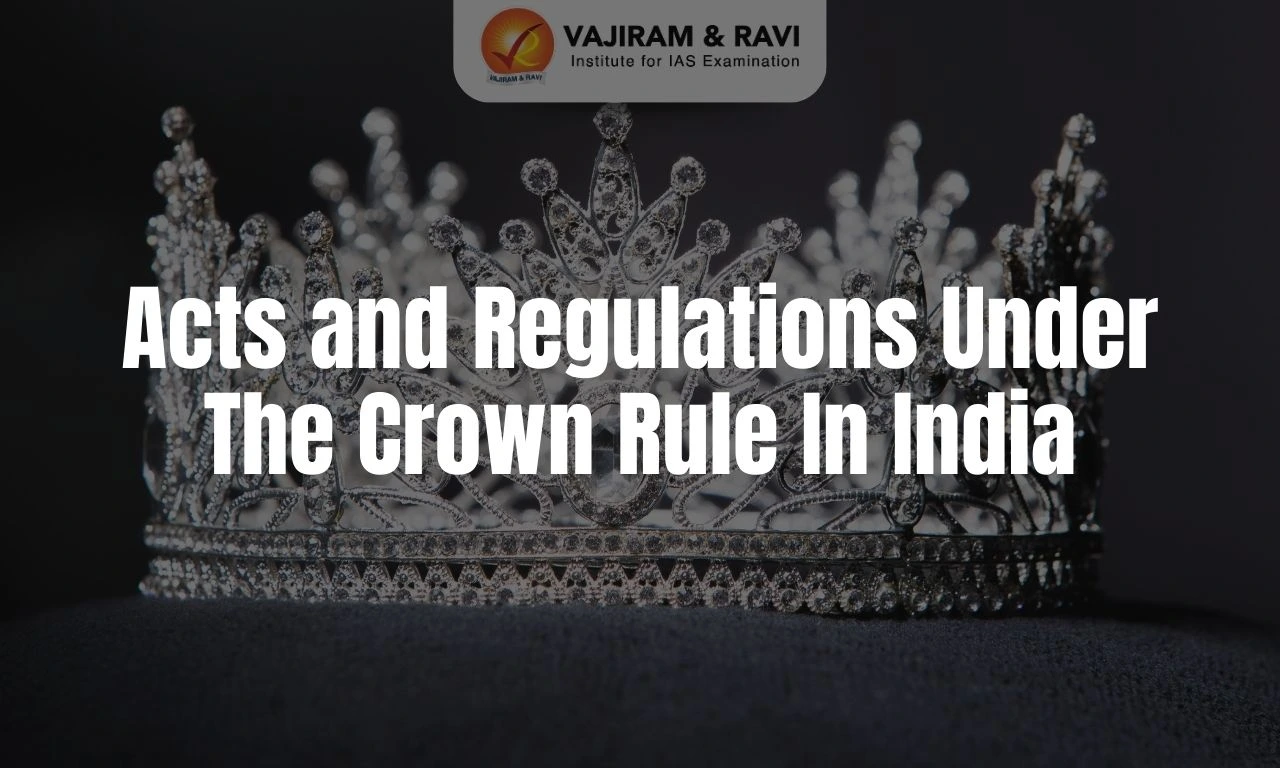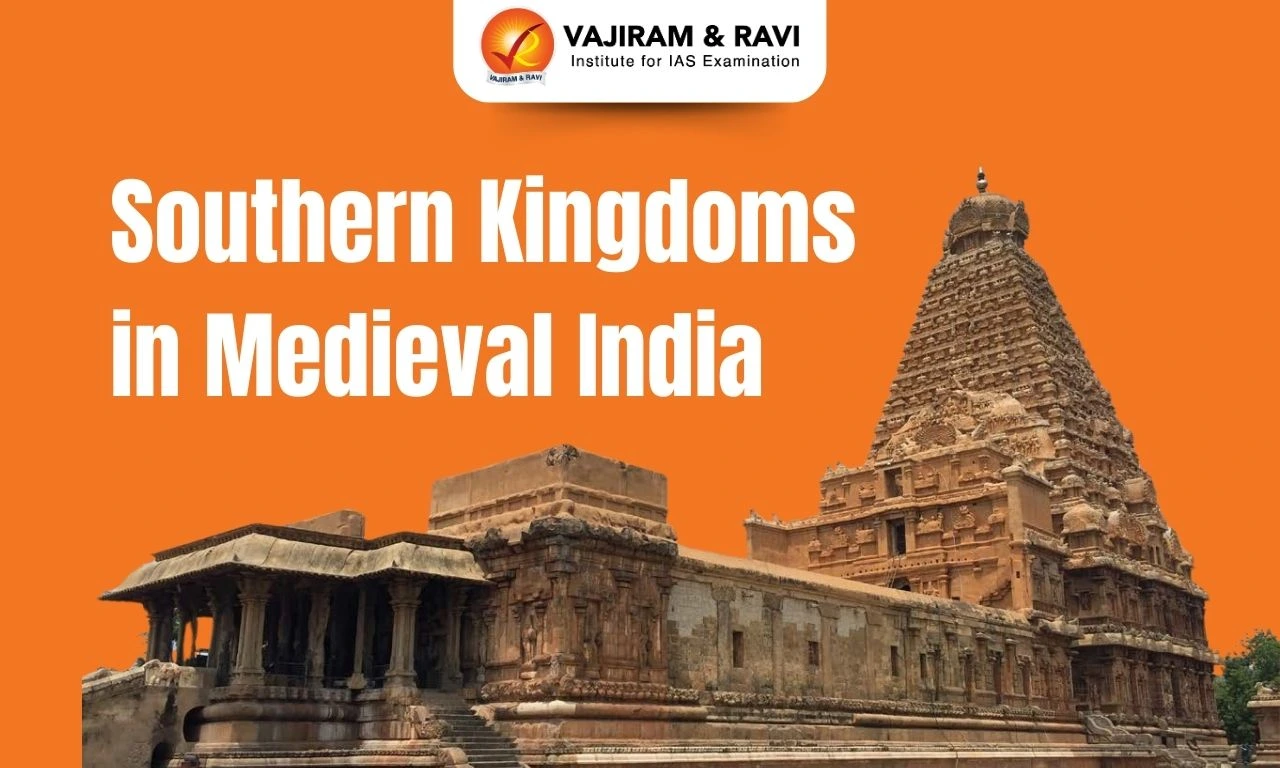Energy flow in ecosystem is a fundamental process that sustains life, as it transfers energy through food chains from one trophic level to another. This flow begins with producers and moves through various consumers to decomposers, all interacting within the biotic (living) and abiotic (non-living) components of the environment. When this flow is disrupted, it can lead to ecological imbalances.
There are two main types of food chains: grazing and detritus, each transferring energy through different sources. While food chains are linear and relatively simple, food webs—comprising multiple interconnected food chains—form more complex networks. These food webs play a critical role in maintaining ecosystem stability, as their interconnected nature makes them more adaptable and resilient to change.
Ecosystem Overview
Ecosystem comprises plants, animals, and their surrounding physical environment, all of which interact with one another. It consists of biotic components, such as plants, animals, and humans, as well as abiotic components like soil, air, and water. Ecosystems are structured into various trophic levels, with energy flowing between these levels to maintain the system's balance.
Energy Flow in Ecosystem
Energy flow in an ecosystem is defined as the movement or transfer of energy from one trophic level to another in an ecosystem. The energy that is passed is in the form of chemical energy. The flow of energy is a fundamental process that sustains life on Earth.
All living components within an ecosystem depend on energy for their survival. Any disruption in this energy flow can result in an ecological imbalance. On Earth, energy is transferred through systems via the biogeochemical cycle.
Energy Flow in Ecosystem Diagram
Food Chain Definition
A food chain is the transfer of energy and nutrients from one organism to another in the form of food. Producers form the base of the food chain, while apex predators occupy the top. Food chains illustrate feeding relationships and interactions among organisms, with each stage referred to as a trophic level. These levels begin with producers and progress through primary, secondary, and tertiary consumers.
- Two main types of food chains exist:
- Grazing food chains, which start with living plants
- Detritus food chains begin with the consumption of dead organic matter
Food Chain Trophic Level
A food web presents a complex network of feeding relationships between organisms in an ecosystem. This complexity can be simplified by classifying organisms into trophic levels based on their energy source. These levels represent distinct feeding positions within an ecosystem.
- 1st Trophic Level (Producers): It belongs to the plants or the producers. Their source of energy is the sun, and their nutrients come from soil, water and atmosphere.
- For example, Green plants and algae act as producers by producing energy-rich organic matter.
- 2nd Trophic Level (Primary Consumers): These are herbivores that feed on producers. Their source of energy or food plants, and they are capable of converting energy stored in plant tissues into animal tissues.
- For example, Zooplankton, which feed on phytoplankton, are primary consumers in aquatic ecosystems.
- 3rd Trophic Level (Secondary Consumers): These are carnivores that feed on herbivores for energy, acting as predators in ecosystems.
- For example, Fish are secondary consumers that feed on zooplankton in aquatic environments.
- 4th Trophic Level (Tertiary Consumers): They feed on both primary and secondary consumers and are strictly carnivorous.
- For example, Owls, which feed on herbivores like mice and smaller carnivores, are tertiary consumers.
- Apex Predators: They are at the top of the food chain with no natural predators, helping maintain ecosystem balance.
- For example, Whale sharks are apex predators in marine ecosystems, feeding on both fish and phytoplankton.
- Decomposers: These organisms feed on dead and decaying plants and animals, converting organic matter into energy and nutrients.
- For example, Bacteria decompose organic matter into nutrients used by plants.
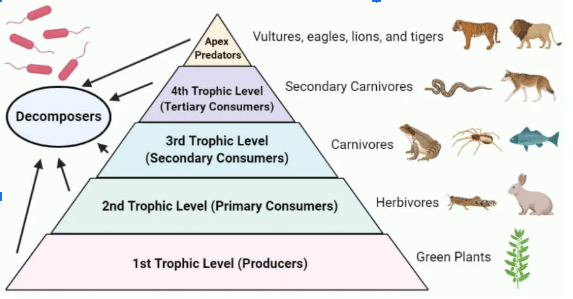
Food Chain Types
A food chain represents the flow of energy from one organism to another, starting from producers and moving through different trophic levels. There are two main types: grazing food chains, where energy originates from photosynthesis and passes from plants to herbivores, and detritus food chains, which begin with the decomposition of dead organic matter, transferring energy through decomposers and predators. Both types are essential for energy transfer in ecosystems.
Grazing Food Chains
A grazing food chain is a type of food chain where energy is derived from photosynthesis. Producers, such as plants, form the base, and the first energy transfer occurs from plants to herbivores at the lowest trophic level. This type of food chain plays a critical role in energy flow, particularly in aquatic ecosystems. Grazing food chains are classified into two types based on the organisms involved:
- Predator Food Chain: Autotrophs are consumed directly by herbivores.
- Parasitic Food Chain: Parasites infect herbivores that consume producers.
Examples of grazing food chains:
- Aquatic: Phytoplankton → Small Fish → Large Fish.
- Terrestrial: Grass → Deer → Lion/Tiger.
Detritus Food Chains
The detritus food chain begins with dead organic material, hence the name. Detritivores or decomposers feed on decaying organic matter, and predators, in turn, consume these detritivores. This food chain plays a vital role in contributing energy to ecosystems and is found in various environments such as oceans, seas, ponds, and lakes.
Energy is transferred from the dead remains of plants and animals to decomposers, which are then eaten by predators. Examples include:
- Dead plant and animal matter is broken down by microorganisms, which are consumed by decomposers like snails or earthworms, and these are eaten by larger animals.
- Dead Organic Matter → Microorganisms → Decomposers
- Mangrove leaves are consumed by small organisms like larvae, crabs, and copepods, which are then eaten by carnivorous fishes, followed by larger fish or fish-eating birds.
- Leaves → Insect Larvae → Fishes → Larger Predators
Difference Between Grazing and Detritus Food Chain
The grazing food chain starts with green plants and relies on solar energy, while the detritus food chain begins with dead organic matter. Both play crucial roles in transferring energy through ecosystems but involve different sources and organisms. The detailed explanation is given below:
|
Basis of Difference |
Grazing Food Chain |
Detritus Food Chain |
|
Definition |
It begins with green plants as the primary source of energy. |
It begins with the dead remains of organisms as its primary source of energy. |
|
Energy Source |
Solar energy |
Dead remains of plants and animals |
|
Organisms Involved |
Macroscopic or sub-soil organisms |
Dominated by microscopic organisms. |
|
Importance |
Energy is released into the ecosystem by the grazing food chain. |
It consumes a significant amount of environmental energy. |
|
First Trophic Level |
Green plants |
Decomposers and Detritivores |
Food Chain Diagram
Food chain diagram effectively illustrates the energy flow within an ecosystem, from producers to consumers and decomposers, showing the interdependence of organisms. It provides a clear, simple representation of who eats whom, making the process easier to understand.
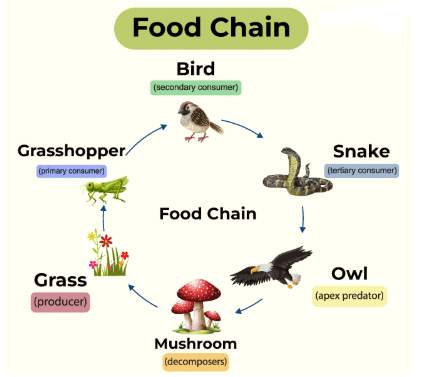
Food Chain Examples
Food chains illustrate the transfer of energy within ecosystems, starting from producers and moving through different consumer levels. In forest ecosystems, oak trees provide sustenance for deer and wolves, while in ocean ecosystems, phytoplankton nourishes fish and larger marine predators.
- Forest ecosystem: Oak trees function as producers, providing nourishment for deer, which are primary consumers. Wolves, acting as secondary consumers, prey on the deer. Fungi, as decomposers, break down organic material like fallen leaves and dead animals, restoring important nutrients to the soil.
- Ocean ecosystems: Phytoplankton act as producers and are consumed by zooplankton, the primary consumers. Small fish, serving as secondary consumers, feed on zooplankton, while larger predatory fish (tertiary consumers) prey on the smaller ones. Decomposers like bacteria break down dead marine life, returning nutrients to the water.
Food Web Definition
Food web is a complex system of overlapping and interconnected food chains that depict the feeding interactions within a community. Unlike a food chain, which shows the flow of energy and matter from one organism to the next, a food web reveals how multiple food chains are linked within an ecosystem.
- It also highlights that most organisms feed on or are eaten by more than one species, a detail that food chains may not always capture.
Food Web Types
Food webs differ significantly across various ecosystems, each highlighting distinct energy transfer processes. These variations demonstrate the complexity of relationships and the adaptability of organisms in their environments.
- Terrestrial food webs: These include habitats like grasslands, forests, and urban areas. These webs involve a vast range of species, from plants to herbivores, carnivores, omnivores, and decomposers.
- Energy is harnessed from the sun by plants, then passed to animals that consume them, and finally to top predators.
- Aquatic food webs: It exist in water environments such as oceans, lakes, and rivers. They begin with producers such as phytoplankton or aquatic plants, which are consumed by small fish and invertebrates.
- This energy flow continues upward to larger fish, marine mammals, and other sea creatures, showcasing the interconnectedness of marine life.
- Desert food webs: In the challenging desert environment, food webs are simpler but essential. They begin with resilient plants like cacti that store water to endure extreme heat.
- These plants support various desert inhabitants, from insects and reptiles to birds and mammals, each adapted to survive food and water scarcity.
- Forest food webs: These are among the most intricate, with layers of biodiversity. These ecosystems range from decomposers on the forest floor to towering trees.
- Energy moves from plants and fruits to a broad spectrum of herbivores, then to predators, creating a complex and dynamic network that sustains a vast diversity of life.
Food Web Diagram
A food web diagram illustrates the complex interactions between various organisms in an ecosystem, showcasing the flow of energy from producers to consumers and predators.It illustrates the way different species, like herbivores, carnivores, and decomposers, are linked together through their feeding interactions.
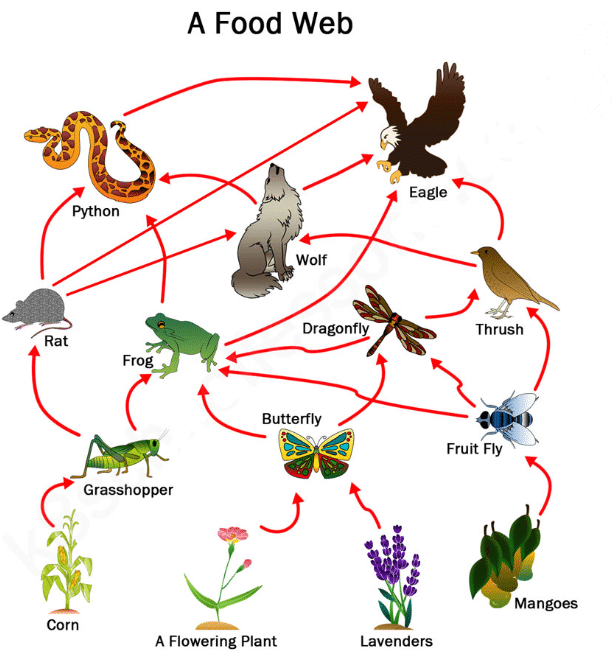
Food Web Examples
Food webs demonstrate the intricate relationships between organisms in different ecosystems. Below are examples that highlight these interactions and the flow of energy across various trophic levels.
- Grassland Ecosystem: Grasses form the foundation, feeding insects and small mammals, which are subsequently hunted by larger predators such as foxes and birds of prey.
- Coral Reef Ecosystem: Algae and plankton create the base, supporting diverse fish species, which are then consumed by larger predators like sharks and rays.
Food Chain And Food Web Difference
The distinction between a food chain and a food web is based on their complexity and structure. A food chain represents a linear flow of energy from one organism to another, while a food web is a complex network of multiple interconnected food chains, showing the feeding relationships in an ecosystem. The detailed explanation is given below:
|
Features |
Food Chain |
Food Web |
|
Types |
Types: grazing and detritus food chains. |
No specific type, interconnected chains. |
|
Arrangement |
Energy flows in a straight, linear pattern. |
Arranged in a web-like structure, connecting multiple chains. |
|
Adaptability |
No adaptability or competition among organisms. |
Competition and adaptability exist. |
|
Structure |
One organism per trophic level. |
Multiple species at each trophic level. |
|
Significance |
Increases instability if present alone. |
Stabilizes ecosystems by maintaining balance. |
|
Example |
Grass → Grasshopper → Frog → Snake → Hawk |
Grass → Grasshopper, Rabbit → Frog, Fox → Snake, Eagle, Lion |
Food Chain and Food Web - Energy Flow in Ecosystem UPSC PYQs
Q1. With reference to food chains in ecosystems, consider the following statements:
- A food chain illustrates the order in which a chain of organisms feed upon each other
- Food chains are found within the populations of a species
- A food chain illustrates the numbers of each organism which are eaten by others
Which of the statements given above is/are correct? (UPSC Prelims 2013)
(a) 1 only
(b) 1 and 2 only
(c) 1, 2 and 3
(d) None
Ans: (a)
Last updated on December, 2025
→ Check out the latest UPSC Syllabus 2026 here.
→ Join Vajiram & Ravi’s Interview Guidance Programme for expert help to crack your final UPSC stage.
→ UPSC Mains Result 2025 is now out.
→ UPSC Notification 2026 is scheduled to be released on January 14, 2026.
→ UPSC Calendar 2026 is released on 15th May, 2025.
→ The UPSC Vacancy 2025 were released 1129, out of which 979 were for UPSC CSE and remaining 150 are for UPSC IFoS.
→ UPSC Prelims 2026 will be conducted on 24th May, 2026 & UPSC Mains 2026 will be conducted on 21st August 2026.
→ The UPSC Selection Process is of 3 stages-Prelims, Mains and Interview.
→ UPSC Result 2024 is released with latest UPSC Marksheet 2024. Check Now!
→ UPSC Prelims Result 2025 is out now for the CSE held on 25 May 2025.
→ UPSC Toppers List 2024 is released now. Shakti Dubey is UPSC AIR 1 2024 Topper.
→ UPSC Prelims Question Paper 2025 and Unofficial Prelims Answer Key 2025 are available now.
→ UPSC Mains Question Paper 2025 is out for Essay, GS 1, 2, 3 & GS 4.
→ UPSC Mains Indian Language Question Paper 2025 is now out.
→ UPSC Mains Optional Question Paper 2025 is now out.
→ Also check Best IAS Coaching in Delhi
Energy Flow in Ecosystem FAQs
Q1. What is called a food chain?+
Q2. What is a simple food chain?+
Q3. Who coined the term food web?+
Q4. What is the main purpose of a food chain and a food web?+
Q5. What is the food chain and food web?+
Tags: energy flow in ecosystem food chain food web quest UPSC Environment and Ecology Notes



